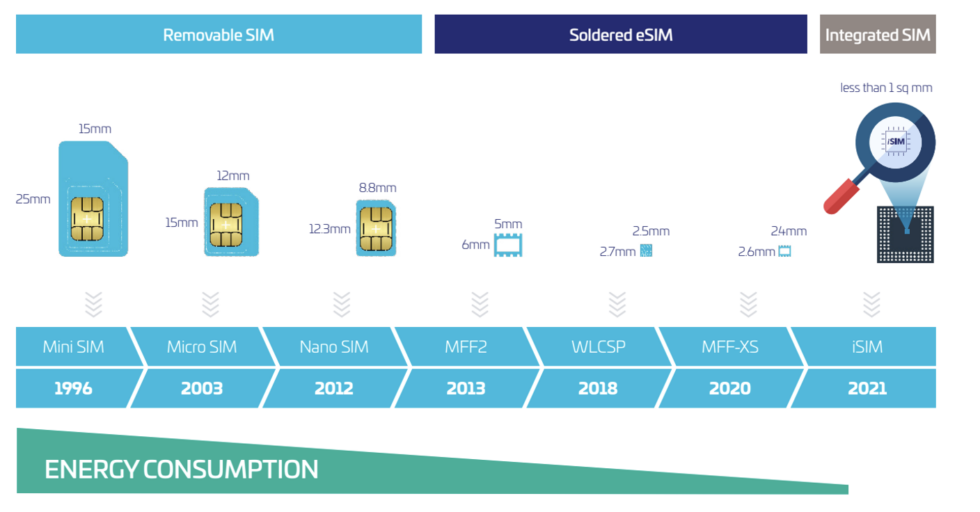well-known chipset manufacturer, mention it Snapdragon 8 Gen 2 has been certified as the “world’s first commercial SoC with iSIM (embedded SIM) support”. But what is iSIM? Didn’t we just switch from a SIM card to an eSIM? True, but iSIM is better than eSIM. The short answer is that iSIM is the next step in the ongoing march to reduce the size of SIM cards.
SIM cards (the smaller “nano” size) are tiny 12 x 9 mm plastic cards that you physically insert into your smartphone. SIM stands for Subscriber Identity Module and these cards mostly only identify you to your mobile operator, allowing your device to connect to them to deliver the monthly service you pay for. The idea is that if you buy a new smartphone or have several smartphones, you can simply move the SIM between them if there are no compatibility issues, transferring the service accordingly from one phone to another.
In the past, these cards used to store some real data, such as contacts and messages, but with the advent of smartphones, all this has been moved to the cloud. Today, a SIM card can store up to 265KB of data on this 12 x 9mm card, which is quite a small capacity when you consider that similarly sized MicroSD cards can hold up to 1TB, or about 4.2 million times over data. SIM cards are a huge waste of space in an industry that’s so strong about saving space, so they had to go.

With eSIMs, we have a new standard that does away with the removable physical SIM and instead puts a small chip on your phone’s motherboard. It came to Google’s Pixel line in 2017, the iPhone in 2018 and some Samsung phones in 2021, and for some models it lived alongside physical SIM cards. The major turning point for most carriers was Apple discontinuing the physical SIM card in 2022 on the iPhone 14s sold in America, which only accepts eSIMs. The eSIM only does not have a removable card at all and thus no card slot, which simplifies device design, saves space and eliminates a potential water entry point. Instead of placing a piece of plastic on the phone, the user can contact their carrier by completing a process that simply contains a QR code. eSIMs offer a large size compared to physical cards, and the smallest chips available are around 2.5 x 2.3 mm.
eSIMs are still a chip that takes up space on the motherboard, which isn’t ideal for manufacturers looking to squeeze every square millimeter out of a phone’s space. The next contraction step is iSIM – Integrated Subscriber Identity Module. Instead of a chip on the motherboard, iSIMs are built directly into the SoC. SoC (System on a Chip) integration is the technology that makes smartphones possible. Instead of a thousand little chips that can handle the CPU, GPU, RAM, modem, and a host of other things, everything is packaged into a single piece of silicon that does everything.
Building everything on a chip, with the smallest transistors you can muster, is the cheapest, most energy- and space-efficient way in the industry, and now SIM cards will hide inside that big block. iSIMs will measure in fractions of a millimeter and, as part of a SoC, will continue to shrink each year as chip processing nodes reach smaller and smaller dimensions. This appears to be the final stage for SIM technology and, in addition to helping manufacturers, would be great for devices with increasingly limited space, such as smartwatches.
Of course, carriers will need to agree to this, and that’s what Qualcomm’s announcement is mostly about. iSIM support in the Snapdragon 8 Gen 2 SoC that appears in the latest Android versions has been certified by the GSMA, or Worldwide Mobile Operators. Qualcomm says that “the new iSIM is fully compliant with the GSMA Remote SIM Provisioning standard – meaning its subscriptions can be managed remotely across any standard platforms.” This is the same standard as an eSIM and the same security requirements are met, so in theory any carrier that works with an eSIM should see no difference between an eSIM and an iSIM. The iSIM is still just a piece of silicon that needs software to connect, and where the silicon is, that shouldn’t matter to your carrier.
Like many of Qualcomm’s SoCs, the use of an iSIM is optional, even though it’s built into the chipset. All current Snapdragon 8 Gen 2 smartphones use separate eSIMs instead of iSIMs. However, now that the solution has been approved, the next step is in the manufacturers’ camp.





More Stories
In Greece Porsche 911 50th Anniversary – How much does it cost?
PS Plus: With a free Harry Potter game, the new season begins on the service
Sony set to unveil PS5 Pro before holiday season – Playstation